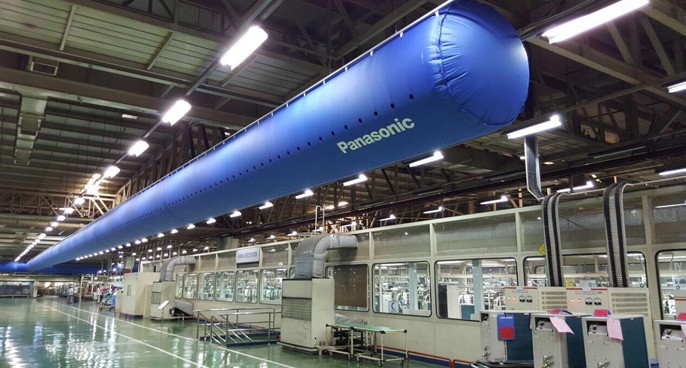Tin tức
Textile Duct Ventilation
Nội dung chính
Textile duct ventilation is an innovative and efficient way to manage air distribution in commercial and industrial spaces. This technology uses permeable fabric ducts to evenly distribute conditioned air throughout a space, promoting optimal comfort and air quality while reducing energy consumption. In this article, we will explore everything you need to know about textile duct ventilation, including how it works, its benefits and drawbacks, alternatives, and tips for installation and maintenance.

Textile duct ventilation, also known as fabric ducting, involves the use of porous textile tubes to transport conditioned air in a space. These ducts are typically made of polyester fabrics and can be customized to fit any space’s specific performance requirements. The fabric ducts have tiny holes that allow air to pass through, creating a uniform air distribution throughout the space.
How Does Textile Duct Ventilation Work?
The process of textile duct ventilation begins with the HVAC unit, where the air is conditioned to the desired temperature. Next, the conditioned air flows through a duct system and into the textile ducts. The air then passes through the perforations in the fabric and enters the room, providing a comfortable and uniform air distribution. Textile ducts are designed to deliver air at low velocities, reducing the likelihood of draft and noise issues.
Pros and Cons of Textile Duct Ventilation
Pros:
- Even air distribution
- Energy-efficient
- Easy to install and maintain
- Customizable design options
- Reduced noise levels
- Lower upfront costs compared to traditional ductwork
Cons:
- Higher ongoing maintenance costs
- Not suitable for high-temperature applications
- Fabric may accumulate dust and require periodic cleaning
- Limited lifespan compared to metal ductwork
- May not be suitable for certain industries with strict hygiene standards
Who Can Benefit from Textile Duct Ventilation?
Textile duct ventilation can benefit a wide range of businesses and industries, including:
- Commercial offices
- Retail spaces
- Warehouses and distribution centers
- Manufacturing facilities
- Cleanrooms and laboratories
- Sports facilities
When is the Best Time to Install Textile Duct Ventilation?
Textile duct ventilation can be installed during initial construction or as a retrofit option for existing buildings. The best time to install this type of ventilation system depends on the specific requirements of the building and the desired level of performance.
How to Install Textile Duct Ventilation
The installation process of textile duct ventilation involves several steps, including:
- Conducting a detailed analysis of the space to determine the specific performance requirements
- Designing custom ductwork to meet these requirements
- Installing the HVAC unit and connecting it to the duct system
- Mounting the fabric ducts onto the ceiling using suspension systems
- Sealing the ductwork to ensure optimal air distribution and efficiency
Alternatives to Textile Duct Ventilation
While textile duct ventilation is an innovative and efficient way to manage air distribution, there are alternative options available, including:
- Metal ductwork
- Underfloor air distribution
- Active chilled beams
- Radiant heating and cooling systems
Tips for Maintaining Textile Duct Ventilation
Proper maintenance is essential to ensure optimal performance and longevity of textile duct ventilation systems. Some tips for maintaining this system include:
- Regularly inspecting the fabric ducts for tears or damage
- Cleaning the fabric ducts periodically to remove accumulated dust and debris
- Checking the HVAC unit and ductwork for leaks or other issues
- Replacing worn or damaged parts promptly
Comparing Textile Duct Ventilation to Traditional Ductwork
Compared to traditional metal ductwork, textile duct ventilation offers several advantages, including:
- Lower upfront costs
- Reduced energy consumption
- Customizable design options
- Even air distribution
- Lower noise levels
However, traditional ductwork also has its advantages, including:
- Longer lifespan
- Suitable for high-temperature applications
- More hygienic for certain industries
- Easier to clean and maintain in some cases
The Best Textile Duct Ventilation System
The best textile duct ventilation system depends on the specific requirements of the space, such as airflow rate, temperature, and humidity control. It’s essential to work with experienced HVAC professionals who can design and install a customized system that meets these requirements and ensures optimal performance and energy efficiency.
Conclusion
Textile duct ventilation is an innovative and efficient way to manage air distribution in commercial and industrial spaces. This technology offers several advantages, including even air distribution, reduced energy consumption, customizable design options, and lower noise levels. However, it’s essential to consider the potential drawbacks, such as higher maintenance costs and limited lifespan compared to metal ductwork. By understanding how textile duct ventilation works, who can benefit from it, and how to install and maintain it, businesses canmake an informed decision about whether this technology is right for their space.
FAQs
- Is textile duct ventilation suitable for all industries? While textile duct ventilation can benefit a wide range of businesses, certain industries may not be suitable due to strict hygiene standards or high-temperature requirements.
- What are the maintenance requirements for textile duct ventilation? Textile duct ventilation requires periodic cleaning to remove accumulated dust and debris. Additionally, it’s essential to inspect the fabric ducts regularly for tears or damage and replace worn or damaged parts promptly.
- How does textile duct ventilation compare to traditional metal ductwork in terms of lifespan? Traditional metal ductwork typically has a longer lifespan than textile ducts, making it a more sustainable option for some businesses.
- Can textile duct ventilation be installed as a retrofit option for existing buildings? Yes, textile duct ventilation can be installed as a retrofit option for existing buildings. However, the specific installation process may vary depending on the building’s layout and construction.
- Is textile duct ventilation energy-efficient? Yes, textile duct ventilation is energy-efficient compared to traditional metal ductwork, as it delivers air at low velocities and reduces the likelihood of draft and noise issues.

